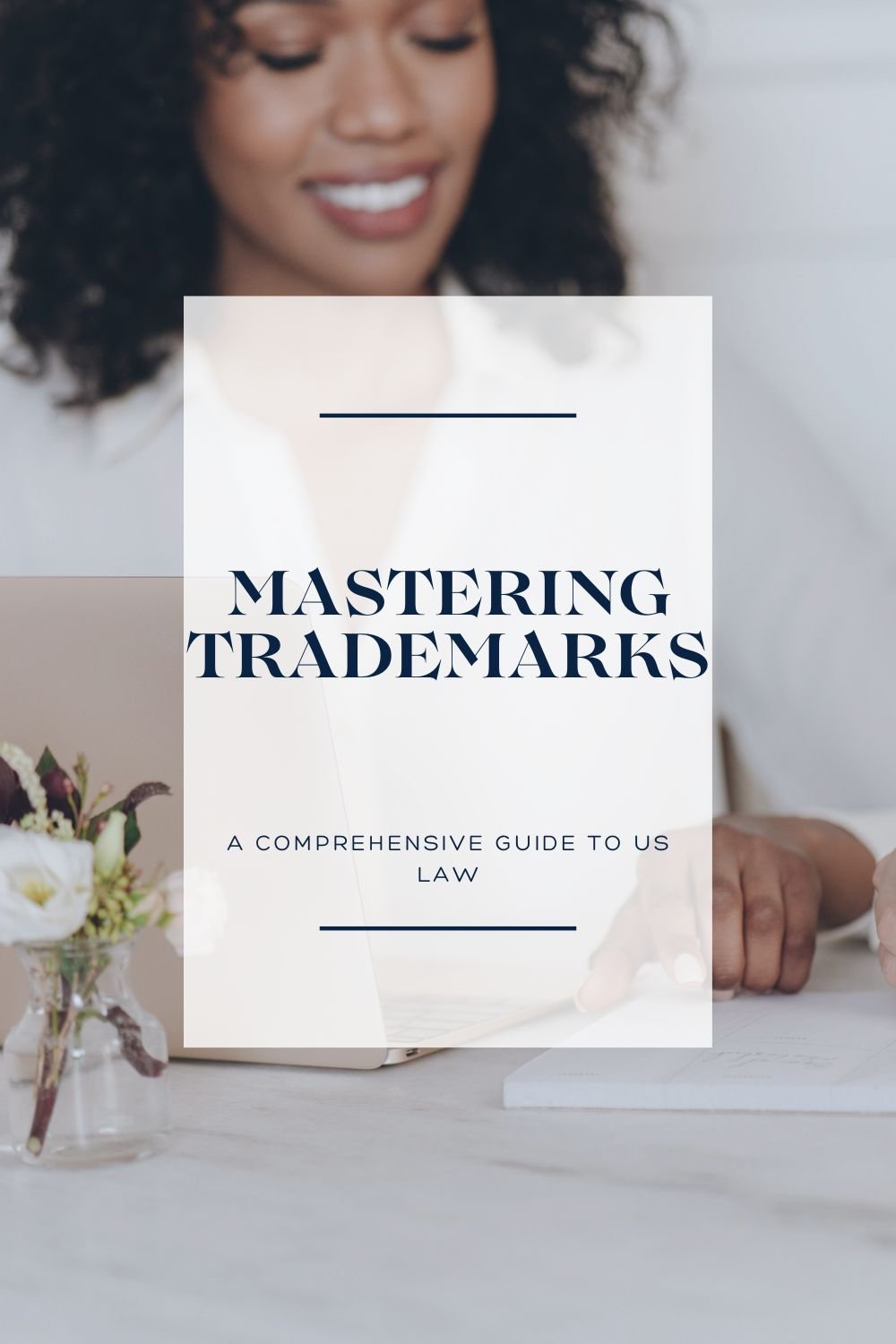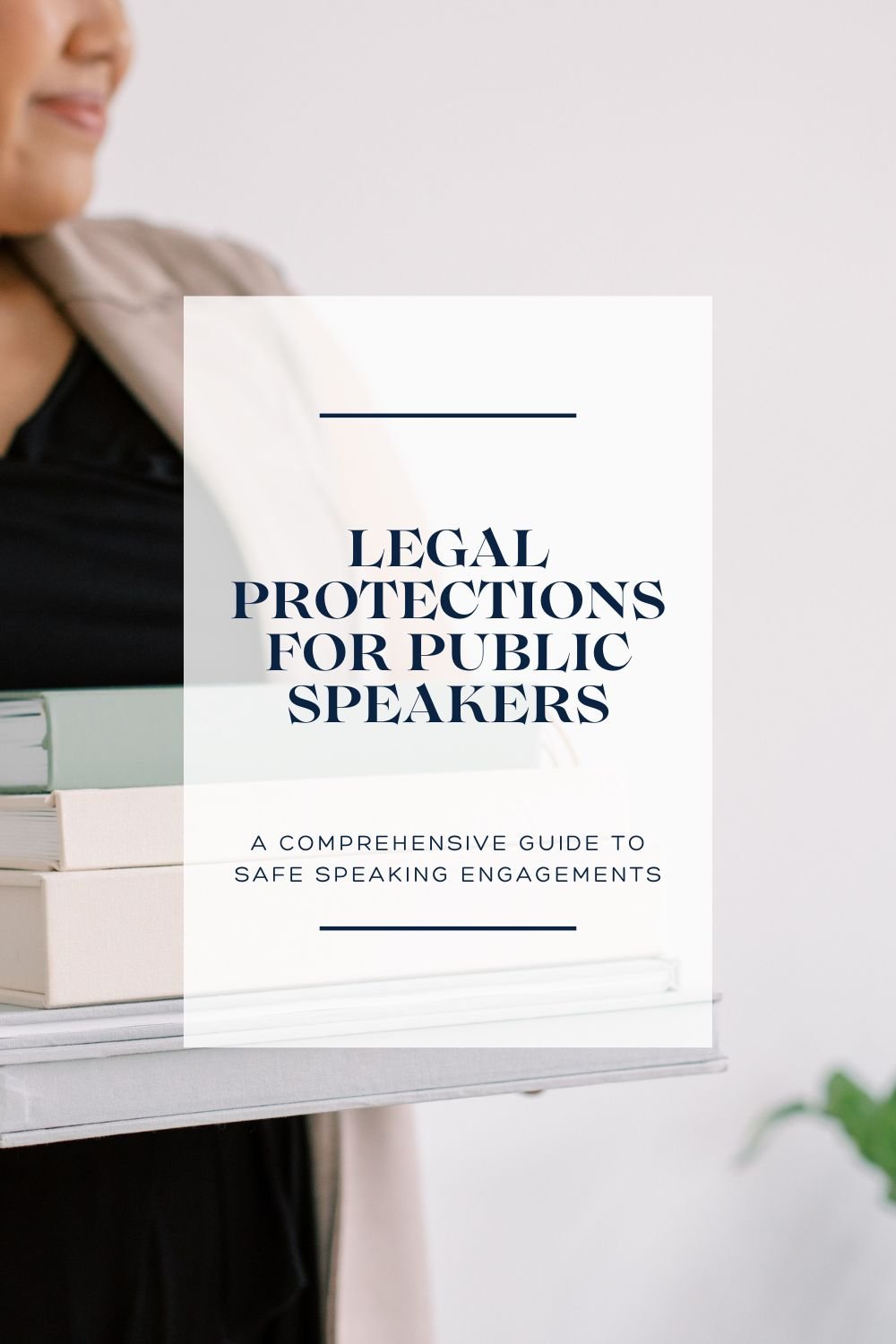Mastering Trademarks for Small Businesses: A Comprehensive Guide to US Law
Hi there, dreamers & dynamos,
Welcome to Trademarks 101.
Confession time, okay? I didn’t really understand trademark law until I was halfway through my LLM degree in Intellectual Property Law. I think I just kind of lumped into copyright and went right on my merry way. I mean, I knew it was important and that my business probably needed one, but it just wasn’t a priority.
Oops.
Learn from my blithe naivety.
Let’s dive deep into the what, how, and why of US trademark law so that your business can get the protection that it deserves. I promise this will be easy-peasy and painless.
In the world of small businesses, your brand identity is not just a mark of recognition; it's a significant and valuable asset. But, when it comes to protecting this asset, many entrepreneurs find themselves navigating the complex world of intellectual property (IP) law and feeling totally unprepared. Let's break down the essence of trademark law, especially as it relates to your small business in the US.
What is a Trademark?
At its core, a trademark is a sign capable of distinguishing the goods or services of one enterprise from those of other enterprises. Basically it helps signify the origin of a product or service. It could be in the form of words, logos, colors, sounds, or even smells. For example, when you see the “Swoosh,” you know that the shoe must come from Nike.
While trademarks fall under the IP umbrella, it's worth noting that there are different IP buckets that your business may need to consider:
Patents protect inventions.
Copyrights safeguard original works of art and literature.
Trademarks shield symbols, names, and slogans used to recognize goods or services.
Now intellectual property is more nuanced than those three quick sentence-long summaries but we’ll be going deep on trademarks for this article. Check my other articles to get crystal clear on copyrights and patents.
Protection Offered by Trademarks:
A registered trademark provides a small business with the exclusive right to use that mark to label their products or services. It serves as a protective shield against unauthorized use, thereby preventing market confusion and ensuring that your brand remains unique.
Owning a trademark is like holding a golden key to your brand's kingdom. Essentially, a trademark grants business owners exclusive rights to use a particular word, phrase, symbol, design, or a combination of these elements, uniquely associated with their goods or services. This means that others cannot use anything confusingly similar to your trademark in the same or related industry, ensuring your brand remains distinct and free from imitators.
How a Trademark Works
But these rights aren't just automatic; they must be actively exercised. If a business spots potential infringement, it's their responsibility to take action. This might start with a cease-and-desist letter, alerting the infringing party of the trademark rights. If not resolved, legal action can be pursued through the courts. This is key because unless you have a registered trademark, the legal system can’t help you if someone else starts using your slogan or business name. Keeping a vigilant eye, routinely monitoring the marketplace, and enforcing trademark rights when necessary not only protects the business but also strengthens the trademark's standing.
Why Trademarks Matter to Entrepreneurs:
For entrepreneurs, a trademark isn't just about legal rights; it's about protecting the goodwill and reputation you've built. Trademarks help businesses establish trust and credibility in the market. Without a trademark, competitors could easily confuse customers by using a similar name or logo, causing not just financial losses but also a potential dent in your business’s reputation. Lest you think trademarks are all just warm and fuzzy brand association, they also have real monetary value and can be bought and sold as a business asset.
What Can Be Trademarked?
When we think about trademarks, the first thing that comes to mind might be brand logos like our good friend the Nike Swoosh or the Olympic’s five interlocking rings. However, intellectual property that can be trademarked extends beyond that. Small businesses often overlook several assets that can (and should) be trademarked:
Business Name: The primary identifier of your brand.
Program or Service Name: Specific services or programs you offer.
Product Name: The name of individual products you sell.
Tagline/Motto: Short phrases associated with your brand.
Logo: The visual representation of your brand.
Trademarking a Personal Name:
Trademarking a personal name can be tricky. The USPTO (United States Patent and Trademark Office) generally requires that the name has acquired a "secondary meaning." This means that when consumers hear the name, they don't just think of the individual but instead associate the name with specific goods or services. So if your business is called “Kerry Carroll LLC,” you might have a hard time getting a trademark.
Selecting the Proper Classification:
When filing for a trademark, it's essential to choose the right class under which your product or service falls. The USPTO has 45 different classes, and selecting the correct one ensures that your trademark protection is valid and robust. While this may seem complicated, it’s actually empowering because it allows businesses in totally separate industries to register the same name without risking confusion. Think of Delta Airlines and Delta Faucets.
Domain Name vs. Business Registration vs. Trademark:
A common misconception among new entrepreneurs is equating a domain name registration or business registration with having a trademark. While registering a domain name is a crucial step in establishing an online presence, it does not prevent others from registering a similar trademark. Weird as it may sound, you could own a domain that is someone else’s trademark. Similarly, while business registration allows you to operate within a state, it doesn't grant exclusive rights nationally or even locally depending on state. Some states will allow multiple businesses to have confusing similar names. A trademark, on the other hand, provides nationwide protection, preventing others from using a name or logo that's confusingly similar to yours.
In essence, while the initial journey of understanding trademarks might seem daunting, the value they offer in protecting a business's brand identity is monumental. As a small business owner, it's not just about building a brand but also ensuring that the brand remains uniquely yours. Investing in a trademark is investing in the future and security of your business.
Navigating the Trademark Application Process:
Navigating the trademark application process can be a bit intricate, especially if you're doing it for the first time. However, it's a necessary step for ensuring your brand's protection.
Preliminary Trademark Search: Before diving headfirst into the trademark application process, conduct a preliminary search using the USPTO’s TESS (Trademark Electronic Search System). This step will help you determine if a similar trademark already exists, thereby reducing the chances of application rejection. But, it's crucial to look beyond exact matches. Variations, phonetic similarities, and translations can also pose conflicts.
Delving Deep into the Trademark Search Process:
When it comes to establishing your brand's unique identity, conducting a comprehensive trademark search is non-negotiable. This process is vital not only to ensure that your desired trademark isn't already in use but also to avoid potential legal complications down the road.
Let's break down the multifaceted nature of this search:
1. Starting with Google: While this might seem rudimentary, beginning your search on Google is a wise move. It offers a broad overview, helping identify any blatant infringements or similar existing trademarks. If nothing surfaces, move on to the next step.
2. Business Registries: Beyond search engines, checking state and local business registries can give insights into businesses operating under names that may not have been registered as federal trademarks but could still pose conflicts.
3. Advanced Trademark Search Tools: While the USPTO's TESS system is valuable, third-party search tools, like Markify or TM TKO, offer sophisticated search algorithms that can catch even obscure similarities. These platforms delve deeper, offering extensive databases and intelligent search capabilities tailored for trademark exploration and are much easier to navigate then TESS’s boolean search parameters.
4. Phonetic and Altered Spellings: A common misconception is only searching for the exact spelling of your desired trademark. It's vital to search for phonetic equivalents, altered spellings, and sound-alike names. For instance, if you're considering "FotoFusion", a search for "PhotoFusion" is equally essential.
5. Possessives, Plurals, and Variations: A singular and plural version of a word can be surprisingly confusing in the eyes of trademark law. Similarly, possessive forms or other slight variations might also pose conflicts.
6. Translations: If you're planning to operate in a multilingual market or if your trademark has meanings in other languages, considering translations is pivotal. A term that's unique in English might be common or already trademarked in another language.
In summary, the trademark search process is not a one-and-done deal. It's a layered, meticulous procedure that demands thoroughness. By diving deep into multiple resources and considering all possible variations, businesses can ensure they're choosing a trademark that's not only unique but also legally defendable. The goal is to build a brand on a rock-solid foundation, ensuring longevity and minimizing potential disputes.
Love This Info? Check Out Related Articles:
Application Filing:
Once you're confident about the uniqueness of your trademark, it's time to file the application. This requires a detailed description of your logo or name, mentioning how it will be used. You'll need to specify the classes of goods or services under which the trademark will be registered. This categorization is paramount to the protection your trademark will offer. Remember that Delta and Delta example?
Bonus fact: Only you, the potential trademark owner, or an attorney may file a trademark application with the USPTO.
Office Actions:
After submission, the USPTO might send 'office actions' or formal letters that could request further information or clarification. These are not outright rejections but indicate areas that need addressing.
Publication Period:
If the USPTO approves, your trademark will be published in the “Official Gazette”, giving others a chance to oppose its registration. If there aren’t any objections within 30 days, the process moves forward.
Registration and Maintenance:
Once registered, it's essential to monitor and enforce your trademark rights actively. Remember, owning a trademark isn't just about acquisition but also about maintenance and protection. Every 5-10 years, depending on the trademark's nature, renewals may be required.
The Value of a Trademark Attorney:
Although it's entirely possible to navigate the trademark process independently, many small business owners opt for the expertise of a trademark attorney. These professionals can guide you through the application process, respond to office actions, and even help enforce your rights if someone infringes on your trademark. Check out my guide on DIY Trademark Registration if you do decide to go it alone (I believe in you!).
Conclusion:
For small businesses, establishing a brand can take months or even years. After investing such substantial effort, time, and money into building your brand identity, protecting it becomes paramount. Trademarks may well be your key in protecting your valuable hard work and effort.
Remember, a trademark does more than just establish brand rights; it provides a foundation upon which businesses can build relationships of trust with consumers. It serves as an assurance of quality and a testament to the brand's reputation.
Moreover, in an era of digital business, where brand theft is rampant, having a registered trademark isn't a luxury – it's a necessity. It's not just about legal prevention; it's about ensuring that the legacy and reputation of your brand remain untainted.
By understanding the intricacies of trademark law and employing it effectively, small businesses can ensure that they're not just surviving in the competitive market but thriving and scaling new heights of success.
THIS ARTICLE IS NOT A SUBSTITUTE FOR LEGAL ADVICE AND IS OFFERED FOR INFORMATIONAL PURPOSES ONLY. EVERY SITUATION IS UNIQUE AND YOU SHOULD CONSULT A LOCAL ATTORNEY FOR ADVICE ON YOUR PARTICULAR CIRCUMSTANCES.





Dive deep into US trademark law tailored for small businesses! Learn the differences between trademarks, patents, and copyrights, and why a domain name isn't enough. Explore the intricate process of trademark searches, and ensure your brand stands out and remains protected. Knowledge is power – empower your business journey!